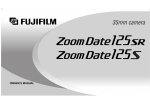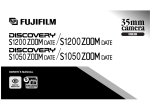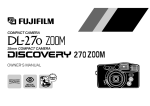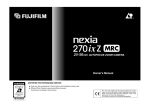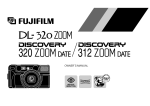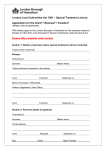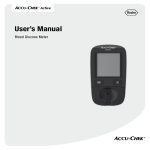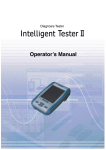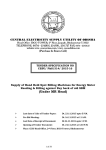Download OWNER`S MANUAL
Transcript
OWNER’S MANUAL CONTENTS FEATURES ............................................................................... 2 PART NAMES ........................................................................... 3 QUICK START GUIDE ............................................................. 6 Menus and modes .................................................................. 9 Finder .................................................................................... 11 AF Lamp ................................................................................ 12 1. PRELIMINARY STEPS ATTACHING THE STRAP ...................................................... 14 LOADING THE BATTERY ...................................................... 15 TURNING ON YOUR CAMERA ............................................. 16 CHECKING YOUR BATTERY ................................................ 17 SETTING THE DATE (YEAR-MONTH-DAY/HOUR-MINUTE) .. 18 SELECTING THE DATE MODE ............................................. 21 2. USING YOUR CAMERA LOADING THE CAMERA ....................................................... 23 USING YOUR CAMERA ......................................................... 27 USING THE AUTO-FOCUS LOCK ........................................ 33 UNLOADING THE FILM OR REMOVING FILM IN MID-ROLL ........................................................................... 35 2 3. ADVANCED TECHNIQUES SELECTING THE FLASH MODE ........................................... 39 SELECTING THE SELF-TIMER MODE ................................. 46 SELECTING THE REMOTE CONTROLLER MODE ............. 49 SELECTING THE FOCUS MODE .......................................... 53 MULTI PROGRAM FLASH ..................................................... 57 TROUBLE SHOOTING ........................................................... 59 COMMON SENSE CAMERA CARE ...................................... 61 SPECIFICATIONS .................................................................. 62 IMPORTANT SAFETY NOTICE ............................................. 64 FEATURES • • • • • • • Super EBC Fujinon 28-100mm Auto Focus Zoom Lens Large LCD Panel with Back Light Multi-Programmed Flash Aluminum Body Self-Timer and Remote Controller Red-Eye Reduction Date/Time Imprinting The “CE” mark certifies that this product satisfies the requirements of the EU (European Union) regarding safety, public health, environment and consumer protection.(“CE” is the abbreviation of Conformité Européenne.) This product is in conformity with Directive 89/336/EEC. PART NAMES 1 7(→p.48,51) 2(→p.51) 3(→p.30) 8(→p.39) 9 4(→p.15) 0 5(→p.14) 6(→p.15) 1 AF (Autofocus) Window 2 Remote Controller Sensor 3 Shutter Release Button 4 Battery Compartment Cover 5 Strap Lug 6 Battery cover release knob 7 Self-Timer/Remote Controller Lamp 8 Flash 9 Viewfinder Window 0 AE Light Sensor A Super EBC Fujinon Lens/ Lens Cover A(→p.16) 3 B C D E F G AF Lamp (green) Viewfinder Eye-piece Film Leader Mark Film Take-up Spool Mid-Roll Rewind Button Film Confirmation Window H Camera Back I Film Pressure Plate J Tripod Socket G(→p.24) B(→p.12) C(→p.11) D(→p.25) E(→p.25) H(→p.24,36) I F(→p.37) J 4 K(→p.12) P(→p.16) L(→p.11) Q(→p.29) M(→p.24,36) R(→p.24) K L M N O P Q R AF Lamp (green) Viewfinder Eye-piece Camera Back Lock Liquid Crystal Display Battery Status Power Button Zoom Button Film Confirmation Window S MENU/SET Button T Four-direction Button U Exposure Counter S(→p.8) N(→p.9) O(→p.17) T(→p.8) U(→p.26) 5 1 QUICK START GUIDE An easy introduction to automatic photography with your FUJIFILM camera. Press the power button to turn the power on. ☞ 2 6 , and photography. Adjust the zoom. are displayed on the LCD and the camera is set for automatic mode 3 4 Compose the picture. Press the shutter button down completely. Excellent pictures can be taken with just the operations described from page 27 on. 7 1 2 3 How to use the MENU/SET button and four-direction button 1 Selecting the menu and mode 2 Selecting the menu ☞ Make the menu you want to change blink/light. 3 Selecting the mode ☞ The current mode blinks. 4 Setting the mode 4 8 ☞ The set mode is displayed. ∗ ∗ The LCD backlight is green (mode set) when the power is turned on and when a mode has been set (goes out after 10 seconds). The LCD backlight is orange (mode selection) while the mode is being selected (goes out after 10 seconds of no operation). When the LCD is difficult to read at night etc, press any of the , , or buttons to turn the backlight (green) on. Menus and modes 23 1 4 5 7 8 6 9 ■ FLASH (→p.39) 1 Multi program flash mode 2 Red-eye reduction flash mode 3 Back light compensation flash mode 4 Flash-off mode 5 Night portrait (slow sync) mode 0 A ■ SELF-TIMER (→p.46,49) 6 Self-timer/Remote control off mode (normal mode) 7 Self-timer mode (1 shot) 8 Self-timer mode (2 continuous shots) 9 Self-timer mode (3 continuous shots) 0 Remote control mode B C D E F G H 9 23 1 ■ FOCUS (→p.53) A AF (Auto focus) mode B Landscape mode C Macro mode 4 5 7 8 ■ DATE (→p.21) D Year-Month-Day E Month-Day-Year F Day-Month-Year G Day-Hour-Minute H Nothing printed 6 0 A ∗ B C D E F G 10 H 9 Examples shown are for 18:15 on the 26th November 2001. Finder A : Framing area Compose the image within this area. B : AF (auto-focus) spot C Position this spot over the main subject in your picture. C : Close-up Frame A When taking close-ups, use these marks as a guide when composing the picture. (→p.31) B 11 AF Lamp 12 When the shutter button is pressed down halfway, the AF lamp (green) lights or blinks. AF lamp status and meaning ∗ When the shutter button is pressed down halfway. Status Lit Rapid blinking Meaning Photography is possible. (Focus and exposure settings complete.) Out of focal range. Ensure that the subject is at least 0.65 m (0.65 m/2.1 ft. - ∞) from the camera. ∗ The shutter lock operates in the Slow blinking mode. Ensure that the subject is 0.5 - 1.0 m (1.6 - 3.3 ft.) from the camera Out of focus. • Ensure that the subject is within the AF frame. • AF can not focus on the subject. Focus on an object of the same brightness and at the same distance as the subject you want to photograph and use the AF lock. ∗ The shutter lock operates in the mode. 13 1 1. PRELIMINARY STEPS ATTACHING THE STRAP Slip the thin cord on the carrying strap through the strap lug on the side of the camera leaving a loop. Slide the thick part of the strap through this loop and pull tight. Take up any slack to make sure the strap is securely attached to the camera. Do not use a strap made for cellular phones or similar electronic products. These straps are usually too light or weak to hold your camera securely. For safety, use only straps designed for cameras. 2 14 CHINESE LOADING THE BATTERY Your camera uses one 3V lithium battery, type CR2/DL CR2. To load the battery. 1 Move the battery cover release knob. 2 Open the battery cover. 2 1 3 Insert the battery following instruction in the diagram on the inside of the battery cover paying particular attention to the position of the , and . poles of the battery. The battery must be inserted the right way or the camera will not function. 4 When the battery is inserted correctly, close the battery compartment cover by pressing it until it snaps into place. 4 3 ∗ ∗ ∗ ∗ ∗ Do not apply excessive force when opening or closing the battery cover. One fresh lithium battery should be sufficient for approximately 250 exposures (based on our test conditions). When traveling, take extra batteries to provide power for extra exposures. This is particularly important if you visit areas where fresh batteries may be difficult to obtain. Check the battery capacity symbol before using your camera. (→p.17) After changing the batteries, reset the date to assure accurate date/time recording. (→p.18) 15 TURNING ON YOUR CAMERA Before you can use your camera, you must turn the power on. First press the power supply button which turns on the power. Pressing this button a second time will turn the power off. ☞ When you turn your camera on, the lens cover will open and the initial display will appear in the LCD. ☞ When the power is turned on, the camera is set for automatic mode photography. (→p.27) ∗ When you are finished using your camera, turn the power off to conserve your battery. If the power supply is left on for more than 7 minutes without the camera being used, the camera will automatically turn itself off. Before you turn the camera on, make sure that the lens is not blocked to avoid any interference with the lens extending into its picture taking position. 16 CHINESE CHECKING YOUR BATTERY 1 2 3 To determine the condition of the battery in your camera, turn the power on and check the battery capacity indicator on the LCD panel. 1 Lit : Battery capacity is OK. 2 Lit : Battery capacity is low. Replace with a new battery. 3 Blinks : Shutter cannot be released because battery is exhausted. Replace with a fresh battery. ∗ ∗ ∗ Check the battery capacity before you start to use your camera. The battery can be replaced even while there is a partially-exposed film in the camera. When the battery is replaced immediately after loading a new film, the camera may not recognize that a film has been loaded. If this happens, open and close the camera back. (→p.59) 17 1 SETTING THE DATE (YEAR-MONTH-DAY/HOUR-MINUTE) Setting the date 1 Turn the camera on and press the MENU/SET button. ☞ The LCD lights orange and the menu selection mode is entered. 2 3 4 18 2 Press any of the ☞ The year “ buttons to the make the DATE menu blink. ” blinks and the date setting mode is entered. 3 Press the buttons to change the numbers which are blinking. 4 Press the buttons to change the item to be set. ☞ The selected item blinks. CHINESE 5 5 When the date has been set, press the MENU/SET button. ☞ The LCD changes to green and the date which has been set is displayed. ☞ To set the time (hour or minute) by the radio, press in the MENU/SET button when the time ∗ signal indicates zero. The year, month, and day will change together with the hour and minute. ● You can set: Year : ’01 to ’31 (2001 to 2031) Month : 1 to 12 Day : 1 to 31 Time : 0 to 23 hours; 00 to 59 minutes 19 1 Changing the date 1 Turn the camera on and press the MENU/SET button. ☞ The LCD lights orange and the menu selection mode is entered. 2 3 4 2 Press any of the buttons to make the DATE menu blink. ☞ The date section blinks. 3 Hold the MENU/SET button down for 2 seconds or longer. ☞ The “Day” blinks and the date change mode is entered. 4 Using the procedure described in steps 3 to 4 on page 18, set the date with the buttons. ☞ When the date has been set, press the MENU/SET button. 20 CHINESE SELECTING THE DATE MODE The date and time (year-month-day/ hour-minute) will be imprinted at the lower right of the photograph. ∗ ∗ The date display printed on the front of the picture may not be clearly visible against a dark background. Since the date is printed on the film when the film is wound on, the date may not be printed on the last frame when more than the standard number of frames are taken. The following DATE modes can be selected. ■ DATE modes ( ) Year-Month-Day ( ) Month-Day-Year ( ) Day-Month-Year ( ) Day-Hour-Minute ( ) Nothing printed ∗ Examples shown are for 18:15 on the 26th November 2001. 21 1 2 3 4 22 1 Turn the camera on and press the MENU/SET button. ☞ The LCD lights orange and the menu selection mode is entered. 2 Press any of the buttons to make the DATE menu blink. ☞ The date mode selection mode is entered. 3 Press the buttons and select the DATE mode. ☞ The selected mode blinks. 4 Press the MENU/SET button to complete the setting. ☞ The LCD changes to green and the mode which has been set is displayed. 2. USING YOUR CAMERA A LOADING THE CAMERA B C Your camera uses standard 35mm film available anywhere. Almost all 35mm films will have a DX coding symbol on the film box and on the cassette itself. Information you will see includes: A : Number of Exposures B : DX Code symbol C : Film Speed (sensitivity to light or ISO rating) • If non-DX coded film is used, the camera’s automatic exposure system automatically sets itself to ISO 100. • Always load and remove film from your camera away from direct sunlight. 23 Check the film check window to make sure no film is loaded into the camera. 1 ∗ Never open the camera back while film is in your camera. Do not load a film immediately before inserting the battery. When the battery is replaced immediately after loading a new film, the camera may not recognize that a film has been loaded. (→p.59) ∗ 2 2 1 24 1 To load the film, slide camera back lock in the direction of the arrow as shown in the picture at left. 2 Open the back as shown. ∗ Never apply excessive force when opening or closing the camera back. Insert the roll of film. 3 4 Be careful not to touch the lens section. A A : FILM TIP mark While holding the film cassette in place, gently pull the end of the film leader out as far as the FILM TIP mark in the camera. ∗ ∗ ∗ Hold the film cassette down so that it does not pop out of the film compartment. Make sure the end of the film is correctly threaded onto the spool. If you should pull the film out too far, remove the film cassette and rotate the longer end of the spool slowly to rewind some of the exposed film and adjust the leader to the correct length to reach the FILM TIP mark. Be careful not to rewind the leader completely into the cassette. 25 5 6 26 Close the camera back. ☞ The film advances automatically. ∗ The type, number of exposures, and speed of the film that has been loaded may be checked with the film check window. Check that the exposure counter (“ ”) appears in the LCD. If the film is not loaded correctly, the film counter is not displayed in the LCD. In this case, insert the film again making sure sits is loaded correctly to permit taking pictures. USING YOUR CAMERA A When the camera is turned on, the camera is set for automatic mode photography. How to take pictures with the automatic mode is explained here. B Automatic mode settings A : Multi program flash mode B : Self-timer/Remote control off mode (normal mode) C : AF (Auto focus) mode ∗ C For details of how to use the other photography modes, refer to “3.ADVANCED TECHNIQUES”. (→p.39) 27 1 Turn the camera on and hold it firmly using both hands as shown in the illustration. ☞ When taking vertical pictures, hold the camera with the flash unit at the top. Before taking important, once-in-a-lifetime pictures such as weddings or special events, take a few test shots to make sure your camera is functioning correctly. If you purchased your camera before going on a trip, shoot a roll or two to familiarize yourself with the operation of the camera. And don’t forget to get an extra set of batteries. You should also keep this instruction book with you for handy reference. 2 28 Make sure that nothing is in front of the lens, the flash, the autofocus windows or the automatic exposure light sensor. 3 To use the zoom lens, press the mark until you see the composition you want in the finder. Pressing the mark will set the lens at the shorter focal lengths to obtain wide-angle coverage. ∗ The focusing range for sharp pictures in the mode is from 0.65 m (2.1 ft.) to ∞. Change the focus mode in the following cases. • Long distance photography: mode (→p.55) • Macro photography (Focal distance 0.5 - 1.0 m (1.6 - 3.3 ft.)): 4 mode (→p.56) Aim at your subject so that it is covered by the whole AF frame. 29 5 Press down the shutter release halfway. ☞ Focusing is complete when the AF lamp (green) lights up. ∗ ∗ 6 Press the shutter button down completely. ☞ The film is advanced to the next frame. ☞ The number shown in the exposure counter will increase by 1 with each frame exposed. ∗ ∗ 30 If you are closer than 65 cm (26 in.) to the subject, the AF lamp will start blinking to warn you that the subject cannot be focused. Note that if you are closer than 30 cm (12 in.) to the subject, the AF lamp turns on but the subject cannot be focused. Although the shutter can be released while the AF lamp is blinking slowly, the picture may be out of focus. (→p.13) The AF lamp and self-timer/remote controller lamp will go off once and reappear immediately after the shutter is released. During the charging time of the flash (when the alarm sign is blinking “ ”) the shutter cannot be released. Close-up photography C A A : Viewfinder B : Print finishing C : Parallax correction mark When photographing a subject that is closer than about 1.0 m (3.3 ft.) from the camera, the area within the frame shown in the diagram on the left will be in the picture. Compose the picture so that the subject that you want to photograph is within the frame. B When taking close ups, an area seen through the viewfinder and the area seen by the lens and actually photographed will be different. This is because the viewfinder and lens are not in the same position, a difference known as “parallax”. The parallax correction mark indicates the difference between what the viewfinder sees and what the lens sees when the picture is taken. C A B 31 There are a few conditions when the camera’s autofocus system may not function accurately. At these times, you should use the “Auto-Focus Lock” settings (→p.33) or the “Landscape Mode” setting (→p.55). Conditions requiring these settings include: • • • • • A 32 B A bright light source within the picture such as the sun near your subject, a strong light reflection such as from water or from the windshield of a car; A mirror or other strongly reflective surface near the center of the picture; When the subject is only composed of vertical lines. When the subject is moving at high speed. When the background is much brighter than the subject. In the following cases, the AF lamp blinks slowly to warn you that the picture is out of focus.The focal distance is fixed at 3.0 m (9.8 ft.) -∞. Å When the contrast of the subject is very low. ı When the subject is composed of a repetitive pattern. 1 2 USING THE AUTO-FOCUS LOCK In the composition shown at left, the AF frame is off the subject (in this case, the people). In this case the lens will not focus on the subject. Move the camera to position the AF frame over the subject. 33 3 With the AF frame positioned over the subject, press down the shutter release button halfway to set the auto-focus lock. 4 While holding the shutter release button halfway down to keep the Auto-Focus lock on, move the camera back to the original position to recompose your picture, then press the shutter release button all the way down. ☞ Check that the AF lamp (green) lights up. ∗ 34 The Auto-Focus lock operation can be repeated any number of times before the shutter trips. 1 UNLOADING THE FILM OR REMOVING FILM IN MID-ROLL To Unload the Film When the last frame in the film has been exposed, the film automatically rewinds into the film cassette which can then be removed for processing. ☞ When rewinding is complete, the exposure counter will read “ ∗ ”. Sometimes more photographs can be taken than the stated number of exposures, but the final frame may not be printed. Check that the motor has stopped and that “ ” is displayed. If the camera back is opened before “ ” is displayed, the following may occur. (→p.38) • The film is exposed to the light. • When the next film is loaded, it is immediately rewound and “ ” blinks. 35 1 Slide the camera back lock in the direction indicated by the arrow. 2 Open the camera back in the direction indicated by the arrow. 2 2 ∗ Do not apply unnecessary force to the camera back. 1 3 36 Remove the film. Removing film in mid-roll Press the button with the point of a pen or something similar. ☞ When rewinding is complete, the exposure counter will read “ ∗ Do not press the ”. button with any object that tapers to a sharp point. Check that the motor has stopped and that “ ” is displayed before removing the film. Film cannot be reused once it has been rewound. Do not press the removing the film for developing. button except when 37 ◆ Do not open the camera back while there is a film in mid-roll in the camera. ☞ If the camera back is opened while there is a film in mid-roll in the camera, the film may be exposed to the light. ☞ The exposure counter is reset to “ ”. If the camera back is opened by mistake: 1 Close the camera back without removing the film. 2 The remaining frames can be used. ∗ 38 Since the exposure counter is reset to “ ” when the camera back is opened, the correct film count is not displayed. However, you can continue to make exposures until the roll is finished at which time you will feel a resistance in the film transport. At this point, rewind the film into the cassette and remove it from the camera. DO NOT TRY TO ADVANCE THE FILM ONCE THIS RESISTANCE IS FELT. 3. ADVANCED TECHNIQUES SELECTING THE FLASH MODE The following flash modes can be selected. ■ FLASH modes ( )Multi program flash mode ( ) Red-eye reduction flash mode ( ) Back light compensation flash mode ( ) Flash-off mode ( ) Night portrait (slow sync) mode ∗ ∗ ∗ Unless the mode is set, the mode is set when the power is turned off. The mode is automatically cancelled per shot. When you want to use this mode continuously, hold the MENU/SET button down for 2 seconds or longer after selecting the mode. (The selected mode will continue to blink even after it is set.) The mode is maintained so that a number of pictures can be taken. The mode is canceled when the power is turned off. When the modes are selected and it is very dark, the flash will fire 1 – 4 times when the shutter button is pressed down halfway in order to illuminate the subject and assist the auto focus. 39 1 2 3 40 1 Turn the camera on and press the MENU/SET button. ☞ The LCD lights orange, the flash menu blinks/lights and the flash mode selection mode is entered. 2 Press the buttons and select the FLASH mode. ☞ The selected mode blinks. 3 Press the MENU/SET button to complete the setting. ☞ The LCD changes to green and the mode which has been set is displayed. The operating range of the film (flash distance) will vary depending upon the film’s sensitivity (ISO speed). When using flash, keep your subject within the range of the effective flash illumination as indicated in the chart below. Effective flash range Film speed Wide angle (28 mm) ISO 100 ISO 400 ISO 800 ISO 1600 0.65 – 2.9 m 2.1 – 9.5 ft. 0.65 – 5.8 m 2.1 – 19.0 ft. 0.65 – 8.1 m 2.1 – 26.6 ft. 0.65 – 11.6 m 2.1 – 38.1 ft. Telephoto (100 mm) 0.65 – 2.0 m 2.1 – 6.6 ft. 0.65 – 4.0 m 2.1 – 13.1 ft. 0.65 – 5.6 m 2.1 – 18.4 ft. 0.65 – 8.0 m 2.1 – 26.2 ft. (Using color negative film) 41 ( ) Multi program flash mode Used for general photography. The quantity of light emitted by the flash is adjusted automatically according to the brightness of the subject, the distance, and the zoom magnification. ∗ For bright remote scenes, the flash does not fire. ( ) Red-eye reduction flash mode Reduce red-eye. The flash will fire briefly 10 times (pre-flash), then fire the 11th time for taking a picture. The AF lamp lights up during the 10 brief flashes (pre-flashes), then goes off when the flash fires for taking the photo. Do not move the camera while the AF lamp is lit. 42 Dealing with red-eye When you photograph a person in dim light using flash, the pupil of the eye will sometimes appear red. Under low light, the pupils of the eye dilate for better vision. Red-eye is caused by light from the flash entering the dilated pupils and being reflected back to the lens. Red-eye reduction causes a preliminary flash to fire before the actual picture is taken. This causes the pupil to contract, reducing this reflection. When the actual flash exposure is made, the degree of reflection is minimized, thus reducing red-eye. When using red-eye reduction mode • • Ask your subject to look directly into the camera. Approach as closely as possible to make your exposure. 43 ( ) Back light compensation flash mode Use this mode to avoid deep shadows when photographing against the light such as a person standing in front of a window or under a tree with a very bright background. This produces more natural looking flash photographs. Unlike the multi program flash mode, the flash fires even in bright places. ( ) Flash-off mode Used when taking pictures under normal room lighting or taking pictures of subject beyond flash range such as in a theatre or a stadium. The flash stops firing. ∗ 44 When taking pictures under low light, use a tripod whenever possible to avoid unsharp pictures resulting from camera shake. ( ) Night portrait (slow sync) mode Used when taking portraits to record the background in a night scene. Your camera will be placed in the slow shutter speed/red-eye reduction mode (The flash fires briefly 10 times (pre-flash), then fires the 11th time for taking a picture.), allowing you to take both the night scene and your subject clearly. ∗ This mode is automatically cancelled per shot. As a slow shutter speed is used with the night portrait mode, ensure that a tripod is used to prevent camera-shake. It is also important that the subject remains motionless during the exposure. 45 SELECTING THE SELF-TIMER MODE The following self-timer/remote control modes can be selected. ■ SELF-TIMER modes ( ) Self-timer/Remote control off mode (normal mode) ( ) Self-timer mode (1 shot) ( ) Self-timer mode (2 continuous shots) ( ) Self-timer mode (3 continuous shots) ( ) Remote control mode (→p.49) ∗ ∗ ∗ 46 The The The mode is automatically set when the power is turned off. mode is automatically cancelled per shot. mode is not cancelled after shooting. 1 1 Turn the camera on and press the MENU/SET button. ☞ The LCD lights orange and the menu selection mode is entered. 1 2 2 Press the buttons to make the SELF-TIMER menu blink/light. ☞ The self-timer mode selection mode is entered. 3 3 Press the 4 4 Press the MENU/SET button to complete the setting. buttons to select “ ” and the number of continuous shots. ☞ Up to 3 continuous shots can be selected. ☞ The LCD changes to green and the mode which has been set is displayed. 47 2 Compose the picture and press the shutter release button. ☞ The camera focuses on the subject that the AF frame is positioned over, and then the self-timer ∗ starts. You can select the Auto-Focus lock mode also. (→p.33) When pressing the shutter release button, do not stand in front of the camera. This may cause a focusing error or underexposure. 3 After the self-timer lamp remains lit for about 7 seconds, it blinks for about 3 seconds, and then the shutter is released. When taking consecutive exposures, the shutter is released the set number of times at an interval of between 3 and 9 seconds. To cancel the self-timer mode after the self-timer has started, press the MENU/SET button. 48 SELECTING THE REMOTE CONTROLLER MODE 1 A remote controller of the proper type is required. B A C Remove the remote controller from its holder by sliding it in the direction of the arrow. A : Remote controller holder B : Transmitter C : Shutter release button ∗ ∗ To replace the remote controller in the holder, slide the remote controller in the direction opposite to the arrow until it clicks into position. The specific remote controller may be different from the one shown in the illustration. 49 1 1 Turn the camera on and press the MENU/SET button. ☞ The LCD lights orange and the menu selection mode is entered. 1 2 3 4 50 2 Press the buttons to make the SELF-TIMER menu blink/light. ☞ The self-timer/remote controller mode selection mode is entered. 3 Press the buttons and select the mode. ☞ The selected mode blinks. 4 Press the MENU/SET button to complete the setting. ☞ The LCD changes to green and “ ” is displayed. 3 4 Aim the AF Frame at your subject and compose your picture. 1 Point the remote controller toward the camera’s remote controller sensor, and then press the remote controller’s shutter release button. 2 After the self-timer/remote controller lamp blinks for about 2 seconds, the shutter is released. The remote controller mode is not cancelled after shooting. It is automatically cancelled when the power is turned off. 51 3.5 m (11.5 ft.) 20° The coverage of the remote controller is up to about 5 m (16.4 ft.) when used directly in front of the camera, and up to about 3.5 m (11.5 ft.) when used at a vertical or horizontal angle of 20°. ∗ ∗ A tripod is recommended when taking pictures by remote control. The remote controller may not work properly when direct sunlight enters the camera’s light sensor from behind your subject. Use the self-timer in such a case. 20° 3.5 m (11.5 ft.) 5 m (16.4 ft.) Fit the remote controller holder to the camera strap for more convenient handling. ∗ 52 The battery life is about three years (tested according to standard test conditions). If the remote controller no longer operates, contact your local retailer where you purchased your camera or our service center. A replacement battery will be available at nominal cost. SELECTING THE FOCUS MODE The following focus modes can be selected. ■ FOCUS modes LCD Mode Available flash modes AF (Auto focus) mode Landscape mode ★1 Macro mode ∗ ∗ The mode is set when the power is turned off. The mode and mode are automatically cancelled per shot. When you want to use these mode continuously, hold the MENU/SET button down for 2 seconds or longer after selecting the mode. (The selected mode will continue to blink even after it is set.) The mode is maintained so that a number of pictures can be taken. The mode is canceled when the power is turned off. ∗ When the mode is set, the focal distance is fixed at 100 mm. ★1 When the mode is selected, the mode is automatically set. After the picture has been taken, the mode is automatically set. 53 1 54 1 Turn the camera on and press the MENU/SET button. ☞ The LCD lights orange and the menu selection mode is entered. 2 2 Press any of the 3 3 Press the 4 4 Press the MENU/SET button to complete the setting. buttons to make the FOCUS menu blink. ☞ The focus mode selection mode is entered. buttons and select the FOCUS mode. ☞ The selected mode blinks. ☞ The LCD changes to green and the mode which has been set is displayed. ( ) AF (Auto focus) mode Used for normal photography. Compose the picture so that the subject is within the AF frame. (→p.28) ( ) Landscape mode Used when taking landscape pictures or photographing remote (night) scenes through window glass. The lens is focused for the distant subjects. The flash does not fire in this mode. ∗ ∗ This mode is automatically cancelled per shot. After the picture has been taken, the flash mode is also automatically set to the mode. When taking pictures under low light, use a tripod whenever possible to avoid unsharp pictures resulting from camera shake. 55 A ( ) Macro mode The macro mode is used when you want to take large pictures of small subjects such as flowers and insects. A : Parallax correction marks The focal distance is fixed at 100 mm. Compose the picture so that the subject that you want to photograph is within the frame. ∗ ∗ The focusing range for sharp pictures is from 0.5 m (1.6 ft.) to 1.0 m (3.3 ft.). This mode is automatically cancelled per shot. •Since this is close-up photography, compose the picture so that the subject is within the parallax correction marks. •When the subject is outside of the focal range, the AF lamp blinks rapidly and the shutter can not be released. (→p.13) •When the subject is out of focus, the AF lamp blinks slowly and the shutter can not be released. (→p.13) Refer to page 32 and use the AF lock. 56 MULTI PROGRAM FLASH A word on multi program flash A new function which allows the camera to automatically adjust the quantity of light emitted by the flash by analyzing the brightness of the subject, the distance, and the focal length of the lens. The flash always fires automatically unless the subject is bright or too far. This programmed flash allows anyone to take clear pictures simply. Some practical examples are introduced to explain the effects. ◆ Close-up photography in a room or night scene When close-up pictures are taken in a dim place with an ordinary flash, it fires at 100%. As a result, the subject is washed out by overexposure. The multi program flash reduces the light quantity down to 12.5%, preventing overexposure. 57 ◆ Portrait photography under very bright light When a person is photographed in bright daylight, his (her) face is likely to be spotted with the shadows of hair and nose. Even in such a case, the multi program flash automatically fires to reduce the shadows. It seems unnecessary to use the flash in a bright place. However, you will understand the effect by comparing a picture taken with the flash used and a picture taken without using the flash. ◆ Photography against the sun When photographing a person who is backlit or standing by a window, the subject appears as a shadow. As a result, the features will be too dark to distinguish. In this case also, the multi-program flash automatically provides the correct amount of light so that you can take beautiful pictures. 58 TROUBLE SHOOTING During operation Problems The shutter release won’t trip. Possible Causes ” symbol is blinking. 1 “ 2 Power switch is not on. 3 Is “ ” blinking on the LCD? 4 “ ” is lit on the exposure counter. 5 Is the AF lamp blinking in the mode? The numerals on the exposure counter blink. After loading the film it rewound immediately. After loading the film and closing the camera back, the exposure counter does not advance. ● Did you remove film without rewinding The film rewound during photographing. ● Did you operate the Solutions Page 1 Replace the battery with a new one. 2 Press the POWER button. 3 The flash is charging. Wait until “ ” stops blinking and is displayed. (The flash takes approximately 6 seconds to charge.) 4 Remove the film, and load an unexposed roll. 5 Photograph at 0.5 - 1.0 m (1.6-3.3 ft.) or use the AF lock so that the AF lamp is lit. ● Remove the battery momentarily, then reload it. 17 16 30 1 Pull the end of the film out to the FILM TIP mark and correctly load the film. 23 23 56 35 it after you began photographing? 1 Did you pull the end of the film out to the FILM TIP mark when loading the film? 2 Did you insert the battery after loading the film? middle of the film? button in the 2 A picture can not be taken by pressing the shutter 17,24 release button in that condition. Open the camera back a little and close it again. ● Be sure not to move the button while film is 37 loaded in the camera. 59 Printed pictures Problems Picture is not sharp. Possible Causes Solutions Page 1 Was your finger on the AF windows when shooting? 2 Did you aim the subject properly? 1 When shooting a picture, hold your camera correctly so that your finger is not on the AF windows. 2 Compose the picture in the AF frame and shoot, or shoot using AF Lock. 3 Clean the lens. 4 Hold the camera firmly and press the shutter release button gently. Use a tripod for slow shutter speeds. 5 Select a mode other than mode. 28 1 Shoot within specified coverage distance of electronic flash. 2 Do not cover the flash with your finger. 3 Turn on mode and press the shutter release button. ● Set date and time after replacing battery. 41 ” before tak1 Select a date mode other than “ ing pictures. 2 Try to arrange that there is nothing light-colored where the date appears. 21 3 Is the lens dirty? 4 Is the camera moving? Picture is too dark. Printed date/time is incorrect. The date is not printed on the front. 60 5 You selected mode when shooting at a close distance. 1 Subject was too far from the camera for flash photography in a dark place. 2 Was your finger over the flash? 3 Was the subject backlit from being taken next to a window, etc.? ● You didn’t set correct date and time after replacing battery. 1 Wasn’t “ ” selected before taking pictures? 2 Is there something light-colored (white, yellow, orange) where the date appears? 33 61 28 53 28 44 18 21 COMMON SENSE CAMERA CARE 1 Although your camera is designed for many years of service, it is a precision instrument and requires thoughtful handling. In particular, avoid exposing it to shock, moisture or physical abuse such as dropping it on the floor. 5 It is recommended that undeveloped film and cameras containing film be carried as hand luggage when flying. If included in checked-in baggage, X-ray inspections may cause overprinting or other effects. 1 If you use your camera at the beach or in a light rain, protect it from moisture. Do not let your camera get wet. Be particularly careful to avoid sand and salt spray at the beach. 6 Remove soil and dust from the lens, the AF window and the finder with an air blower and by wiping lightly with a piece of soft cloth. If that is not enough, wipe off gently with Lens Cleaning Paper, moistened slightly with Lens Cleaning Liquid. Do not use organic solvents such as alcohol and benzene. 7 Dust and debris in the film compartment can scratch the film. Use a blower brush to clean it. 8 9 Load and remove film away from direct sunlight. 0 Since the performance of the battery will drop in cold weather, warm the battery by placing it inside your garments, etc. before use. The performance of a battery whose performance has temporarily dropped can be restored by returning the battery to normal temperature. 2 Dropping your camera or letting it strike a hard surface could result in damage even though the camera was in a case. Never subject the camera to vibration such as in the trunk of a car. Never keep your camera in the trunk or the glove compartment of a car: the heat build-up can damage it. 2 Your camera is computer-controlled so it seldom, if ever, will operate erroneously. If you should experience erroneous operation, remove the battery and then reload it. 3 If you will not be using your camera for some time, store it where it will be safe from heat, moisture, dust and harmful gases such as napthalene (moth balls and moth flakes). 4 Never store the camera in a closed automobile for an extended period. The operating temperature range of the camera is from –10°C to +40°C. With a few common sense precautions, your camera will give you years of faithful service, great pleasure and wonderful pictures. 61 SPECIFICATIONS 62 • Film • Exposure Control 135 (35 mm) DX roll film • Picture Size 24 mm × 36 mm • Lens Super EBC Fujinon zoom lens, 6 components, 6 elements, f=28 – 100 mm 1:5.8 – 1:10.5 • Viewfinder Real image zoom finder, 0.32 – 1.00 × magnification, with AF frame, parallax correction mark, AF lamp • Focusing Passive auto focus, 0.65 m/2.1 ft. – ∞, with AF lock, landscape mode (long distance lens position setting, flash off setting), macro mode (f=100 mm fixed, focal distance: 0.5 - 1.0 m /1.6 - 3.3 ft), AF lamp • Shutter Release Programmed electronic shutter release, 1 – 1/500 sec. shutter speeds Automatic Interlocking range (ISO 100), EV (wide angle): 10.4 (∗6) – 17, EV (telephoto): 13.6 (∗7.1) – 17 (∗ = values for the flash off mode) • Film Speed Setting Automatic (DX roll film) for speeds from ISO 50-3200 • Film Loading Automatic • Film Advance Automatic (motorized), film wind and rewind system, provision for mid-roll rewinding • Flash Multi program flash, 6 seconds recycle time, multi program flash mode, red-eye reduction flash mode, back light compensation flash mode, flash-off mode, night portrait (slow sync) mode • Self-Timer Electronically controlled, up to 3 consecutive exposures approximately 10 second delay, can be stopped mid-run, selftimer on lamp • Liquid Crystal Display Exposure counter, flash mode, self-timer/remote control mode, focus mode, date mode, battery capacity sign, flash charging sign. • Power Supply One CR2/DL CR2 lithium battery • Others Tripod socket, Remote controller (compatible) • Dimensions & Weight 107.0 × 60.0 × 36.0 mm/4.2 × 2.4 × 1.4 in. (main unit), 175 g/6.2 oz. (without battery) ∗ Specifications are subject to change without notice. 63 IMPORTANT SAFETY NOTICE This product has been developed to be as safe as possible when used for its designed purposes. Under normal circumstances, this product will provide long, safe service when handled correctly. It is important, however, that this product is handled properly and used only for photographic purposes. For your convenience and safety, please follow the recommendations listed below. It is also a good idea to keep this manual in a safe, convenience place where you can refer to it easily if necessary. WARNING CAUTION This symbol indicates a potentially dangerous situation which could result in serious injury or even death if these instructions are not followed. This symbol indicates a potentially damaging situation which could result in injury to other people or damage to object, if these instructions are not followed and the product is handled improperly. WARNING Never attempt to take this part apart. There is a serious danger of a powerful electric shock. If this product is dropped or damaged so that the interior is exposed, do not touch anything. There is danger of a severe electric shock. If the camera or the batteries within become hot, begin to smoke, produce a burning smell or display any sign of abnormal or unusual condition, remove the batteries immediately. Use gloves to prevent the possibility of burning your hands. Failure to remove batteries under these conditions could result in burns or even fire. Using a flash too close to a person’s eyes may temporarily affect the eyesight. Take particular care when photographing infants and young children. If your camera gets wet or if foreign objects such as pieces of metal get inside, remove the batteries immediate to avoid any possible heat buildup or of fire starting inside the camera. 64 WARNING Do not use this camera in locations with a high concentration of inflammable gas or near open gasoline, Benzine, paint thinner or other volatile substances which can give off dangerous vapors. Failure to observe this precaution could result in explosion or fire. Store your camera out of the reach of small children. Failure could follow this recommendation could result in serious injury. (For example, the strap could become entwined around their necks with potentially serious consequences.) Never dismantle the batteries when they are removed from the camera. Do not subject them to heat, throw them into an open fire, attempt to recharge them or to short circuit them. Failure to follow this recommendation could result in the batteries exploding or splitting open. Use only the type of batteries specified in your camera’s instructions. Failure to do so may result in excessive heat buildup or even in a fire. Make sure batteries are stored in a safe, secure place well out of the reach of any small children or pets. Improper store could result in a child swallowing a battery. (If a child does swallow a battery, call a doctor or nearest hospital immediately.) CAUTION Never get this product wet or handle it with wet hands. Doing so may result in an electric shock. Never take flash photographs of people riding bicycles, driving cars or riding a horse. The flash can distract the driver and frighten the animal, possibly causing a serious accident. Observe correct polarity when inserting batteries. Never insert batteries with the + and - poles back to front. Failure to observe correct handling might result in the batteries splitting open and leaking, possibly resulting in fire, burns or damage to surrounding objects. 65 26-30, Nishiazabu 2-chome, Minato- ku, Tokyo 106-8620, Japan. <FUJIFILM ABROAD> In North America FUJI PHOTO FILM U.S.A., INC. 555 Taxter Road, Elmsford, N.Y. 10523, U.S.A. FUJI PHOTO FILM CANADA INC. 275 Britannia Road East, Mississauga, Ontario , L4Z 2E7, Canada FUJI PHOTO FILM HAWAII, INC. 1650 Kalakaua Avenue, Honolulu, Hawaii 96826, U.S.A. In Europe FUJI PHOTO FILM (EUROPE) G.m.b.H. Heesenstrasse 31, 40549 Dusseldorf, Germany FUJI PHOTO FILM (U.K.) LTD. Fuji Film House, 125 Finchley Road, Swiss Cottage, London NW3 6JH, England FUJI FILM ESPAÑA, S.A. Aragon, 180, 08011-Barcelona, Spain In South America FUJI PHOTO FILM DO BRAZIL LTDA. Avenida Vereador Jose Diniz No. 3.400, Campo Belo- CEP 04.604 Cx. Postal 9.959., Sao Paulo-SP, Brazil In Asia FUJI PHOTO FILM CO., LTD., HONG KONG OFFICE Room 916, Sun Plaza, 28 Canton Road, Tsim Sha Tsui, Kowloon, Hong Kong FUJI PHOTO FILM (SINGAPORE) PTE. LTD. 10 New Industrial Road, Singapore 536201 FUJI PHOTO FILM (THAILAND) LTD. S.P. Building, 8th Floor, 388 Phaholyothin Road, Bangkok 10400, Thailand FUJI PHOTO FILM (MALAYSIA) SDN. BHD. Letter Box 3, 3rd Floor Office Block 1, Crystal Plaza Lot 4, Jalan 51A/223, 46100 Petaling Jaya Selangor Darul Ehsan Malaysia FUJI PHOTO FILM CO., LTD., TAIPEI OFFICE Rm. 601, Hung Chong Bldg., No.38, Sec. 6, Min Chuan E. Road, Taipei 11412, Taiwan, Republic of China FUJI PHOTO FILM CO., LTD., SEOUL OFFICE Samduck Bldg. 6F., 144-1, Samsung-Dong, Kang Nam-ku, Seoul 135-090, Korea FUJI PHOTO FILM CO., LTD., BEIJING REPRESENTATIVE OFFICE Beijing Fortune Bldg. No. 817, 5, Dong Sanhuan Bei-lu, Chaoyang District, Beijing, China 100004 FUJI PHOTO FILM CO., LTD., HO CHI MINH OFFICE 29-31 Ton That Thiep St., Q.I Ho Chi Minh City, Vietnam FUJI PHOTO FILM CO., LTD., NEW DELHI OFFICE Le Meridian Commercial Tower 8F Janpath, New Delhi 110001, India In Oceania FUJI PHOTO FILM CO., LTD., SYDNEY REPRESENTATIVE OFFICE c/o Hanimex Pty. Limited, Old Pittwater Road, Brookvale, N.S.W. 2100, Australia In Middle East FUJI PHOTO FILM CO., LTD., DUBAI OFFICE No. 4G-17, L.O.B. No. 4, P.O. BOX 17212, Jebel Ali, Dubai, U.A.E. Printed in Indonesia FGS-103106-Ci-01


































































